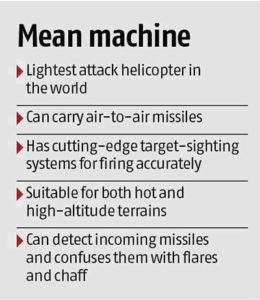Hindustan Aeronautics Light Combat Chopper Cutting Its Teeth In Ladakh
12 August, 2020
The IAF and the army have together projected a requirement for 162 LCHs
A day after the Ministry of Defence (MoD) cleared the acquisition of Hindustan Aeronautics Ltd’s (HAL’s) HTT-40 basic trainer aircraft, HAL announced that its light combat helicopter (LCH) is also ready for combat deployment.
“In light of the prevailing situation on the (Ladakh) border, two HAL-produced LCHs have been deployed for operations at high altitude in the Leh sector,” the company announced on Wednesday.
“The Vice Chief of Air Staff, Air Marshal Harjit Singh Arora, took part in one such operation recently by taking off from a high-altitude location to a forward area for a simulated attack on a high-altitude target. This was followed by a landing at one of the most treacherous helipads in the region,” stated HAL.
“[The LCH] is the lightest attack helicopter in the world, designed and developed by HAL to meet the specific and unique requirements of the armed forces,” said R Madhavan, the HAL chief.
Madhavan was referring to the 5.8-tonne, twin-pilot helicopter’s unique ability to operate at altitudes of 20,000 ft; higher than any other attack helicopter in the world. Having demonstrated its ability to land on, and take off from, helipads at 15,000 ft altitude at Siachen Glacier with combat loads of fuel and weaponry, the LCH can support the army in areas like Galwan and Daulat Beg Oldi, 16,000-17,000 ft high posts where Indian soldiers are confronting Chinese intruders.
With infantrymen at those oxygen-deprived altitudes unable to carry heavy weaponry for long distances, a high-altitude attack helicopter provides them with priceless fire support, using its on-board, 20-millimetre turret gun, 70-millimetre rockets and air-to-air missiles. It can also carry an anti-tank guided missile (ATGM), and the IAF is close to choosing one.

For firing accurately, the LCH has cutting-edge target-sighting systems, including an electro-optic pod and a helmet mounted display that allows a pilot to aim at a target just by looking at it.
Providing the LCH battlefield survivability, it is fitted with armoured panels, self-sealing fuel tanks, a bulletproof windshield, damage-tolerant rotor blades and a main gearbox that can run for 30 minutes even after a bullet hits it and drains out the oil. The LCH is being fitted with an electronic warfare (EW) system that detects incoming missiles and confuses them by scattering flares and chaff.
“All these characteristics make it most suitable for hot and high-altitude operations,” says HAL.
The IAF and the army have together projected a requirement for 162 LCHs: 65 for the IAF and 97 for the army. The MoD has approved the construction of an initial batch of 15 helicopters: 10 for the IAF and five for the army. A contract is expected to be placed shortly, but HAL officials say they have already begun production at their Bengaluru facility.
The order for 15 LCHs is called a limited series production (LSP) order. These choppers will be flown by IAF and army pilots to gauge their performance and capability. These pilots will provide operational performance feedback and recommend improvements that HAL can introduce into the LCH’s design.
Those incremental improvements will go into the series production LCH that will be mass-manufactured on a final production line. This process is expected to take about two more years.
Development of an indigenous helicopter is a continuing process. Through its service lifetime, the chopper will be improved gradually through successive variants — called Mark, Mark 2 and so on. The Dhruv Advanced Light Helicopter is currently being built in its Mark 3 and Mark 4 iterations. Further development is underway, especially on the version being supplied to the navy and coast guard, which have 32 Dhruvs on order.
Courtesy: Opera News/ business-standard.com

